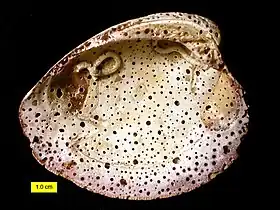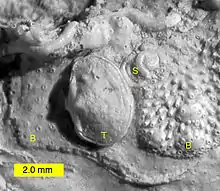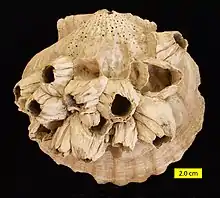Sclerobionts are collectively known as organisms living in or on any kind of hard substrate (Taylor and Wilson, 2003). A few examples of sclerobionts include Entobia borings, Gastrochaenolites borings, Talpina borings, serpulids, encrusting oysters, encrusting foraminiferans, Stomatopora bryozoans, and “Berenicea” bryozoans.
 Entobia sponge borings and the cyclostome bryozoan Voigtopora thurni on an oyster valve from the Coon Creek Beds of the Ripley Formation (Upper Cretaceous) near Blue Springs, Mississippi.
Entobia sponge borings and the cyclostome bryozoan Voigtopora thurni on an oyster valve from the Coon Creek Beds of the Ripley Formation (Upper Cretaceous) near Blue Springs, Mississippi.
 Thecideide brachiopod (T), sabellid worm tube (S) and bryozoans (B) on the shell of the bivalve Ctenostreon from the Upper Jurassic of Poland.
Thecideide brachiopod (T), sabellid worm tube (S) and bryozoans (B) on the shell of the bivalve Ctenostreon from the Upper Jurassic of Poland. Serpulid worms enrusting Pecten; Duck Harbor Beach on Cape Cod Bay, Wellfleet, Massachusetts.
Serpulid worms enrusting Pecten; Duck Harbor Beach on Cape Cod Bay, Wellfleet, Massachusetts.
See also
References
- Taylor, P. D.; Wilson, M. A. (2003). "Palaeoecology and evolution of marine hard substrate communities" (PDF). Earth-Science Reviews. 62 (1–2): 1–103. Bibcode:2003ESRv...62....1T. doi:10.1016/S0012-8252(02)00131-9. Archived from the original (PDF) on 2009-03-25.
Wikimedia Commons has media related to Bioerosion.
This article is issued from Wikipedia. The text is licensed under Creative Commons - Attribution - Sharealike. Additional terms may apply for the media files.